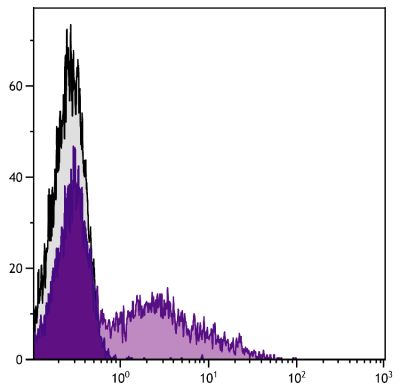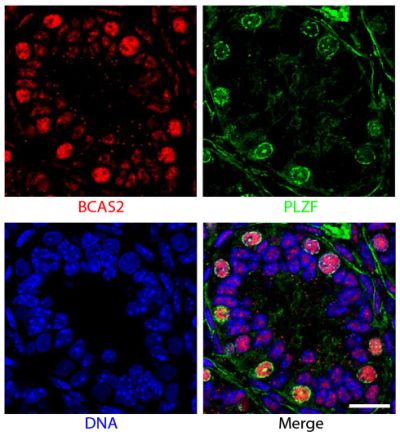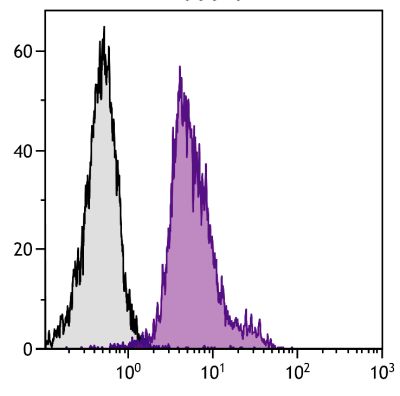Rat Anti-Mouse CD18-BIOT (C71/16)
Cat. No.:
1570-08
Biotin Anti-Mouse CD18 antibody for use in flow cytometry, immunohistochemistry / immunocytochemistry, ELISA, western blot, and immunoprecipitation assays.
$289.00


| Clone | C71/16 |
|---|---|
| Isotype | Rat (Lewis) IgG2aκ |
| Isotype Control | Rat IgG2a-BIOT (KLH/G2a-1-1) |
| Specificity | Mouse CD18 |
| Alternative Names | Integrin β2, ITGB2 |
| Description | CD18 represents the common β2 integrin subunit that associates non-covalently with the α/β chains of CD11a, CD11b, and CD11c to form various integrin heterodimers. It is expressed strongly on lymphocytes and monocytes and weakly on granulocytes. CD18 mediates a variety of heterotypic and homotypic intercellular adhesion reactions and it regulates the ligand-binding activates of the various CD11/CD18 complexes. The monoclonal antibody C71/16 has not been reported to inhibit cell adhesion. |
| Immunogen | Cell membrane glycoproteins derived from mouse BW5147 T cell lymphoma cells |
| Conjugate | BIOT (Biotin) |
| Buffer Formulation | Phosphate buffered saline containing < 0.1% sodium azide |
| Clonality | Monoclonal |
| Concentration | 0.5 mg/mL |
| Volume | 1.0 mL |
| Recommended Storage | 2-8°C |
| Applications |
Flow Cytometry – Quality tested 2 Immunohistochemistry-Frozen Sections – Reported in literature 3 Immunohistochemistry-Paraffin Sections – Reported in literature 4 Immunocytochemistry – Reported in literature 2 Immunoprecipitation – Reported in literature 1,2 Western Blot – Reported in literature 2 ELISA – Reported in literature 5 |
| RRID Number | AB_2794942 |
| Gene ID |
16414 (Mouse) |
| Gene ID Symbol |
Itgb2 (Mouse) |
| Gene ID Aliases | 2E6; LAD; Cd18; Lfa1; MF17; LCAMB; AI528527 |
| UniProt ID |
P11835 (Mouse |
| UniProt Name |
ITB2_MOUSE (Mouse) |
Documentation
Certificate of Analysis Lookup
Enter the Catalog Number and Lot Number for the Certificate of Analysis you wish to view
- 1. Trowbridge IS, Omary MB. Molecular complexity of leukocyte surface glycoproteins related to the macrophage differentiation antigen Mac-1. J Exp Med. 1981;154:1517-24. (Immunogen, IP)
- 2. Choi EY, Orlova VV, Fagerholm SC, Nurmi SM, Chang L, Ballantyne CM, et al. Regulation of LFA-1-dependent inflammatory cell recruitment by Cbl-b and 14-3-3 proteins. Blood. 2008;111:3607-14. (IP, WB, ICC, FC)
- 3. Bullard DC, Scharffetter-Kochanek K, McArthur MJ, Chosay JG, McBride ME, Montgomery CA, et al. A polygenic mouse model of psoriasiform skin disease in CD18-deficient mice. Proc Natl Acad Sci USA. 1996;93:2116-21. (IHC-FS)
- 4. Gerth AJ, Lin L, Neurath MF, Glimcher LH, Peng SL. An innate cell-mediated, murine ulcerative colitis-like syndrome in the absence of nuclear factor of activated T cells. Gastroenterology. 2004;126:1115-21. (IHC-PS)
- 5. Shirakabe K, Shibagaki Y, Yoshimura A, Koyasu S, Hattori S. A proteomic approach for the elucidation of the specificity of ectodomain shedding. J Proteomics. 2014;98:233-43. (ELISA)
See All References





